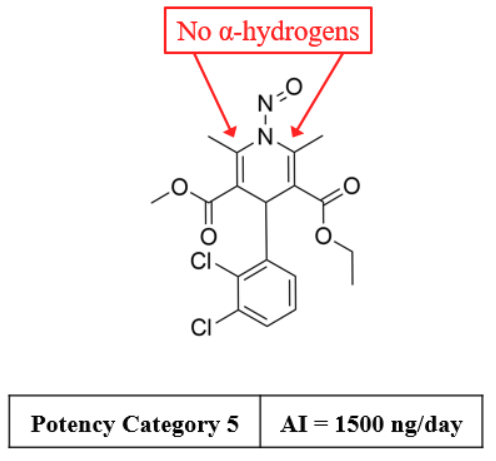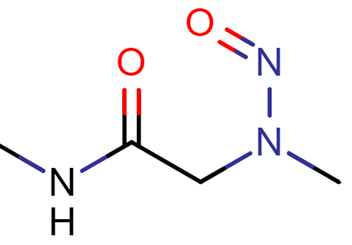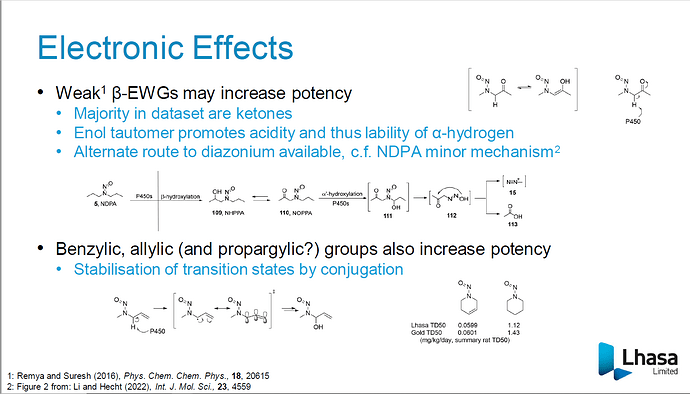As you know, if transgenic mice assays are done, most of these will be non-COC. this is what at one time I was pushing for endogenous nitrosation studies. I was thinking that even in some models, they can show that the secondary amines nitrosate, we can justify not controlling them at the ridiculous levels that were initially proposed. However, we should not be too excited, for high dose drugs, we still need to do work to make sure that the nitrosamines can be controlled above 1.5 mcg/day. I am especially worried about some antibiotics.
Koepke worked downstairs from me and we both worked on beta hydroxy nitrosamines. This is just a one dose study. That is why it is not acceptable to the agencies. But there are drugs like orphenadrine where more work needs to be done.
I worked a lot with this compound and you are right David, this study was quickly done and had a different purpose.
As EMA was starting to look at nitrosamides, I wrote a white paper in a hurry to indicate that these are not nitrosamines but “Nitrosamides”. I have a posting here “Nitrosamides - horse of a different color”. These products are direct acting carcinogens and should not be treated as nitrosamines. So, you can do a general Ames assay to see if they are positive. also, treat them as mutagenic impurity and use SAR. Most of them will have higher limits. Again, they are not nitrosamines. So, dont apply any nitrosamine related limits to these. Also, they dont have to meet any nitrosamine related deadlines.
Nitrosamides–Should They Be Treated the Same as Nitrosamines?
Published on: October 15, 2022
Aloka Srinivasan, Chuck Lambert
Pharmaceutical Technology, Pharmaceutical Technology, Trends in Formulation, October 2022, Volume 2022 eBook, Issue 3
Pages: 42–50
check my paper Nitrosamides–Should They Be Treated the Same as Nitrosamines?
As we discussed, “dipines” are considered impossible to be synthesized. Example 1 may not be appropriate.
Example 1 –N-Nitroso-felodipine

Thank you for clarification.
Fully agree that iso-propyl group lead to reduction of the diazonium potency.
Do you have any experience on the following groups (benzyl, allyl or propargyl like) which have quite different reactivity than iso-propyl group ?
Thank you
Jerome Cluzeau
Sandoz
Benzyl-isopropyl as you’ve drawn matches one of the activating feature patterns in the guidance - the benzyl group increases the metabolic lability of the a-hydrogen. This is exactly the substructure in the potent carcinogen nitrosonornicotine, and there is some evidence (which we summarised in Thomas et al) that the isopropyl site is in this case as reactive as the CH2!
The allyl group should have a similar effect on the activation as the benzyl does because it has a similar effect on bond dissociation energy of the a-hydrogen, though I assume that there is less direct evidence of its effect on carcinogenic potency which would be why it was not included in the current guidance.
The propargyl group might (this is a topic of debate between myself and some other researchers) have a similar effect, but there’s even less potency data to validate against…
If you’ve got any data on these, either toxicity or theoretical such as BDE, please share it (or DM me if it’s not for general viewing) - would love to discuss further!
Hi, @Cluzeauj
@David’s slide helps to understand the electronic effects of functional groups visually. And benzylic group is included in Activating Feature in CPCA, as @David explained. Branched chains are not considered a problem here.
Example 7 – N-Nitroso-sertraline
Hi all,
Thanks for the info @Yosukemino @David . Maybe asking some support here, considering the part of “Weak Beta EWGs may increase potency”. What about amides? Should it be considered a deactivating feature, activating one or none of them?
For example the following sub-structure:

This is where the specific definitions of these groups come into play… our definition of the “weak b-EWGs” included all the carbonyl derivatives, including amides - this gives the conceptually very clear pattern of “*C=O is weak”.
However, as I’ve stated, the potency-increasing effect of these is driven by the ketones. The EMA have taken a different ‘cut’ of the data, listing effectively all C=O compounds alongside the existing ‘strong’ EWGs, but then excluding ketones specifically from the list. This has the same effect of separating the potent ketones from the compounds we expect to be reduced in potency, but allows the other carbonyl-derived EWGs - including amides - to be considered as potency-reducing features, increasing (significantly) the number of compounds considered to have EWGs.
Thanks David, very clear explanation of my question and the topic in general.
Thank you David
i don’t have example for now but if i get one, i will definitely share.
@Yosukemino dear could you please advise on the limit of n-nitroso-vonoprazan based on the scoring system

Thank you for asking me, @Alaaelkazak. I posted the result of the calculation in the following thread. Category 1 is appropriate for N-nitroso-vonoprazan.
Dear, i think the following:
- The pyrrole group is electron withdrawing attached to the alpha carbon on one side (+1)
- The pyrrole group is not an aryl (it’s neither benzylic nor pseudo-benzylic)
Accordingly, 1+1= 2. This corresponds to 100 ng/day which is very near to the FDA set limit of 96 ng/day.
What do you think?
Of course, I may need to refresh my chemistry knowledge, so please accept my apology of I’m wrong @Yosukemino ![]()
Thank you for correcting me, @Alaaelkazak.
According to the EMA Q&A, available EWGs as deactivating features are those described in @kpcross and @David 's paper.
**Excludes carboxylic acid and aryl (counted separately), and ketone (conflicting data). Additional electron withdrawing group examples are limited to those described in Cross KP and Ponting DJ, 2021, Developing Structure-Activity Relationships for N-Nitrosamine Activity, Comput Toxicol, 20:100186, where they are referred to as “β-carbon electron withdrawing groups."
The pyrrole group can not be used as electron withdrawing group. And N-nitroso-vonoprazan will be in category 1(Potency Score: 1), I think.
To confirm, you have excluded the activating feature and accordingly only the count of hydrogen will be considered. Am I right?
Please do not miss the post from @ccdw regarding activating feature ‘Methyl group bonded to beta-carbon’



